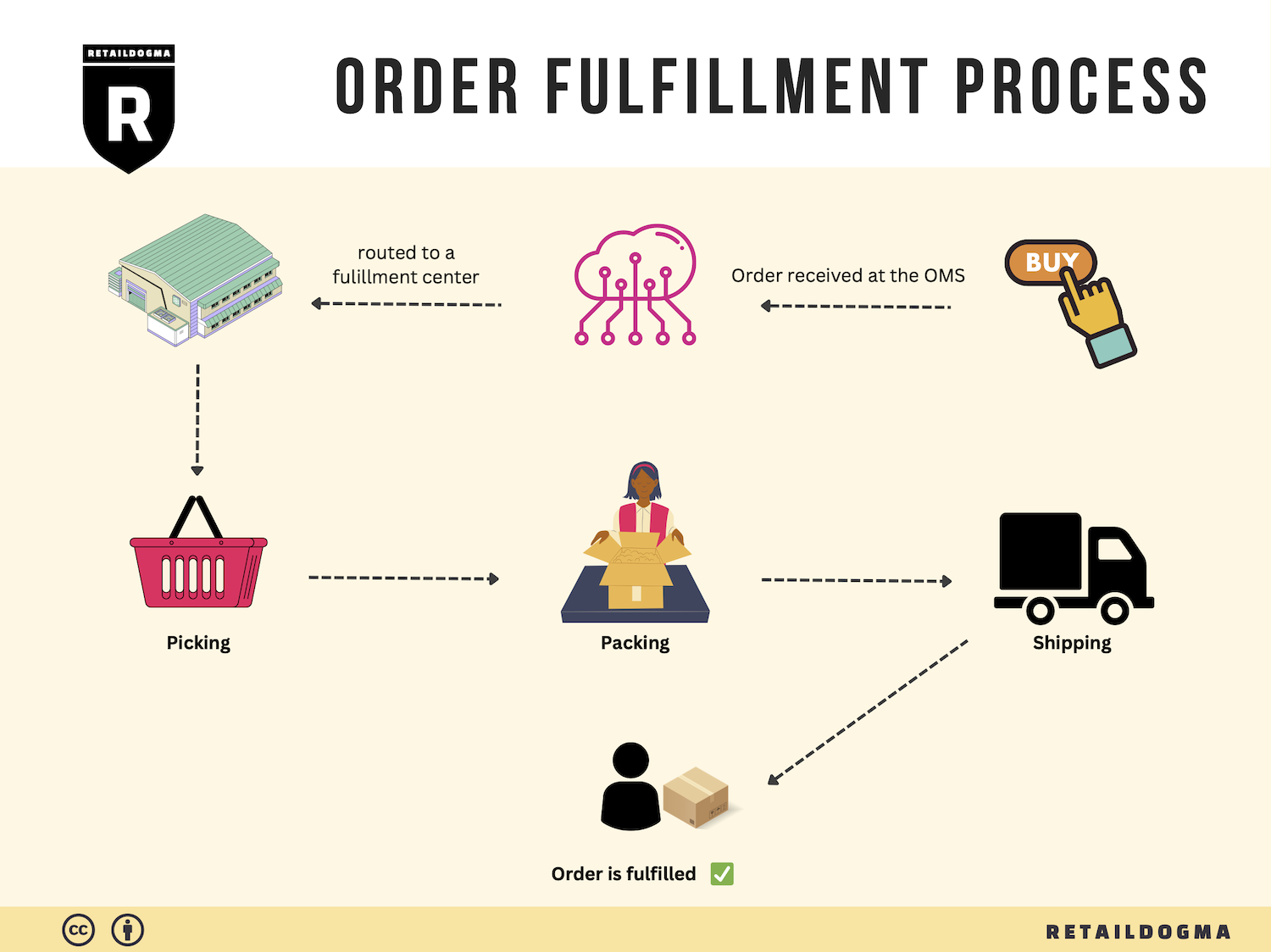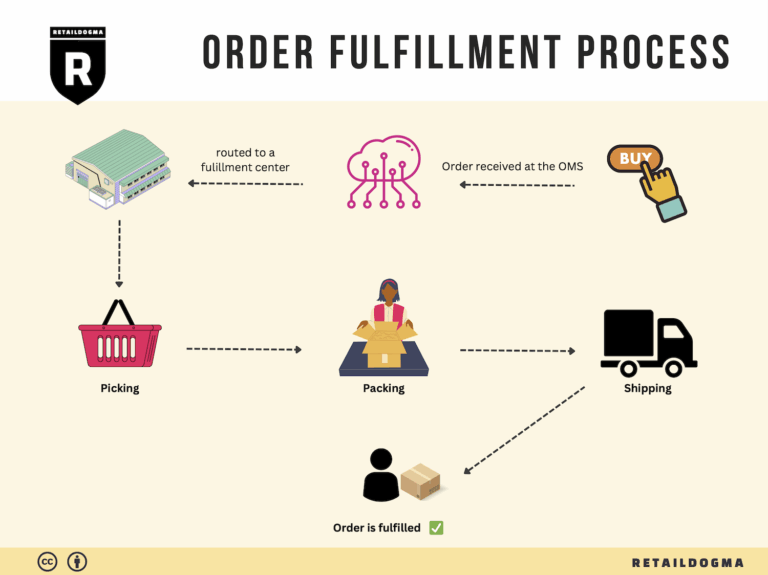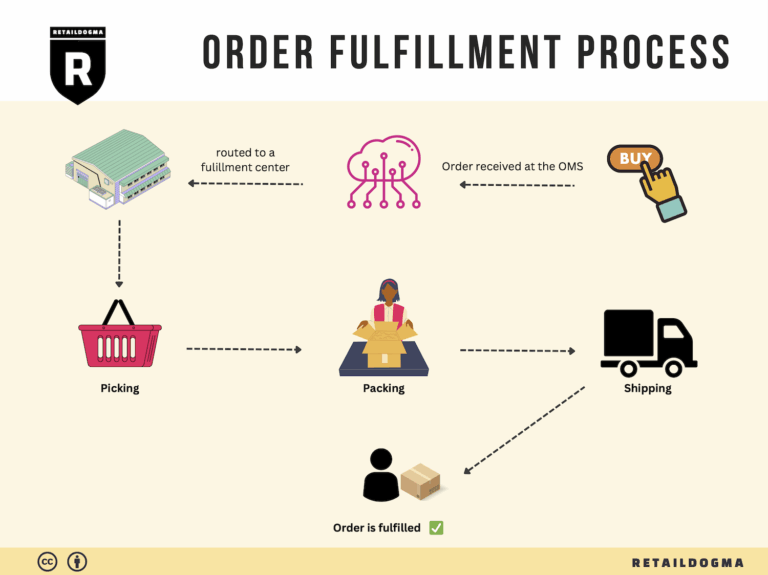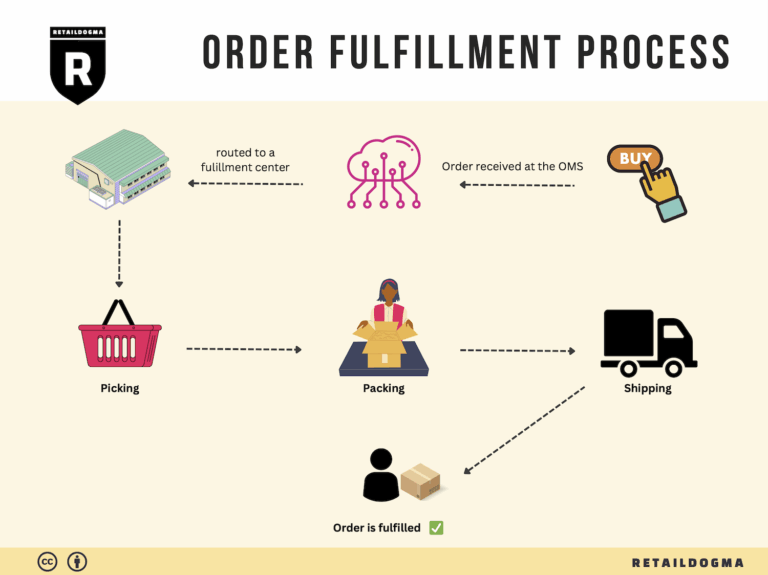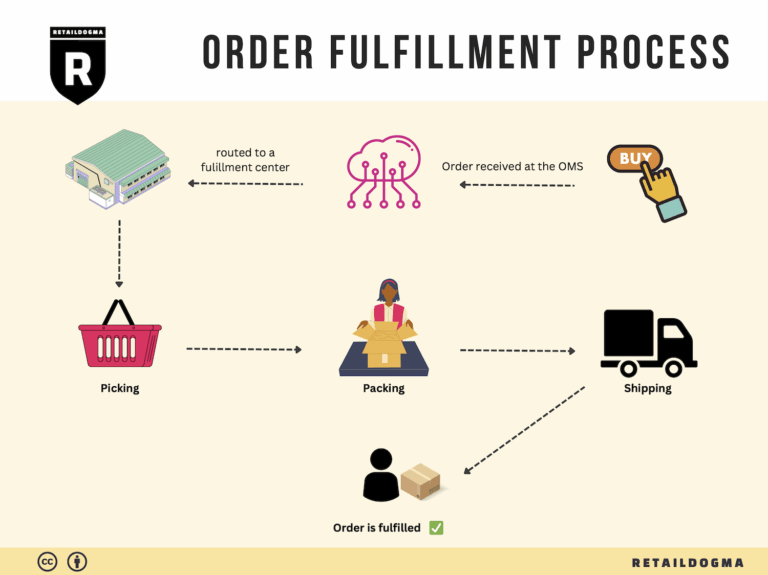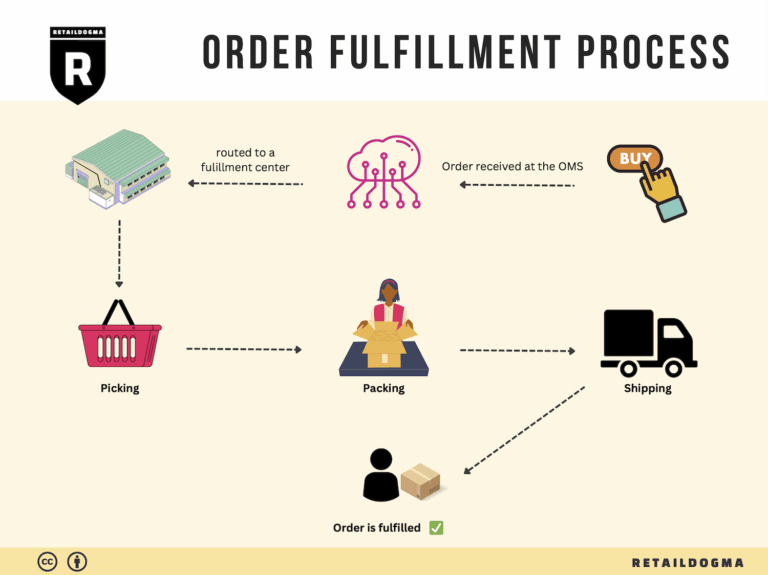How Order Fulfillment Works: A Step-by-Step Guide for Businesses
What is E-commerce Fulfillment? An Introduction for Growing Businesses
As e-commerce businesses grow, many owners and managers find themselves grappling with the complexities of packing and shipping orders. This often leads to overwhelming feelings of frustration as they juggle inventory management, order processing, and logistics—all while trying to maintain customer satisfaction. The reality is that fulfillment is more than just a logistical task; it’s a critical aspect of your business that can significantly impact your bottom line and overall customer experience.
Defining E-commerce Fulfillment
At its core, e-commerce fulfillment refers to the entire process of getting a product from your warehouse to the customer’s doorstep. This includes receiving inventory, storing products, picking and packing orders, and shipping them out. Effective fulfillment is essential for ensuring that customers receive their orders on time, which is increasingly becoming a key differentiator in the competitive e-commerce landscape.
What This Guide Covers
This guide aims to demystify e-commerce fulfillment for growing businesses by exploring various fulfillment models, including Third-Party Logistics (3PL) and Fulfillment by Amazon (FBA). We will dive into the core services offered by fulfillment partners, such as inventory management, order processing, packaging, and shipping. Understanding these services will help you identify which aspects of fulfillment are most crucial for your business needs.
Additionally, we’ll discuss how to choose the right fulfillment partner. Selecting a partner who aligns with your business goals can streamline operations and enhance customer satisfaction. We’ll examine key factors to consider, such as scalability, technology integration, and service levels, ensuring that you make an informed decision.
Pricing and Cost Considerations
Cost is always a significant factor in any business decision. We will outline the pricing structures commonly associated with different fulfillment services, helping you understand what to expect and how to budget effectively.
Empowering Your Business Decisions
Ultimately, the goal of this guide is to empower you to make informed and strategic decisions about your logistics. By understanding the ins and outs of e-commerce fulfillment, you can optimize your operations, reduce overhead costs, and enhance the customer experience—setting your business up for sustainable growth. Whether you’re just starting or looking to scale, effective fulfillment strategies can give you the competitive edge you need in today’s fast-paced e-commerce environment.
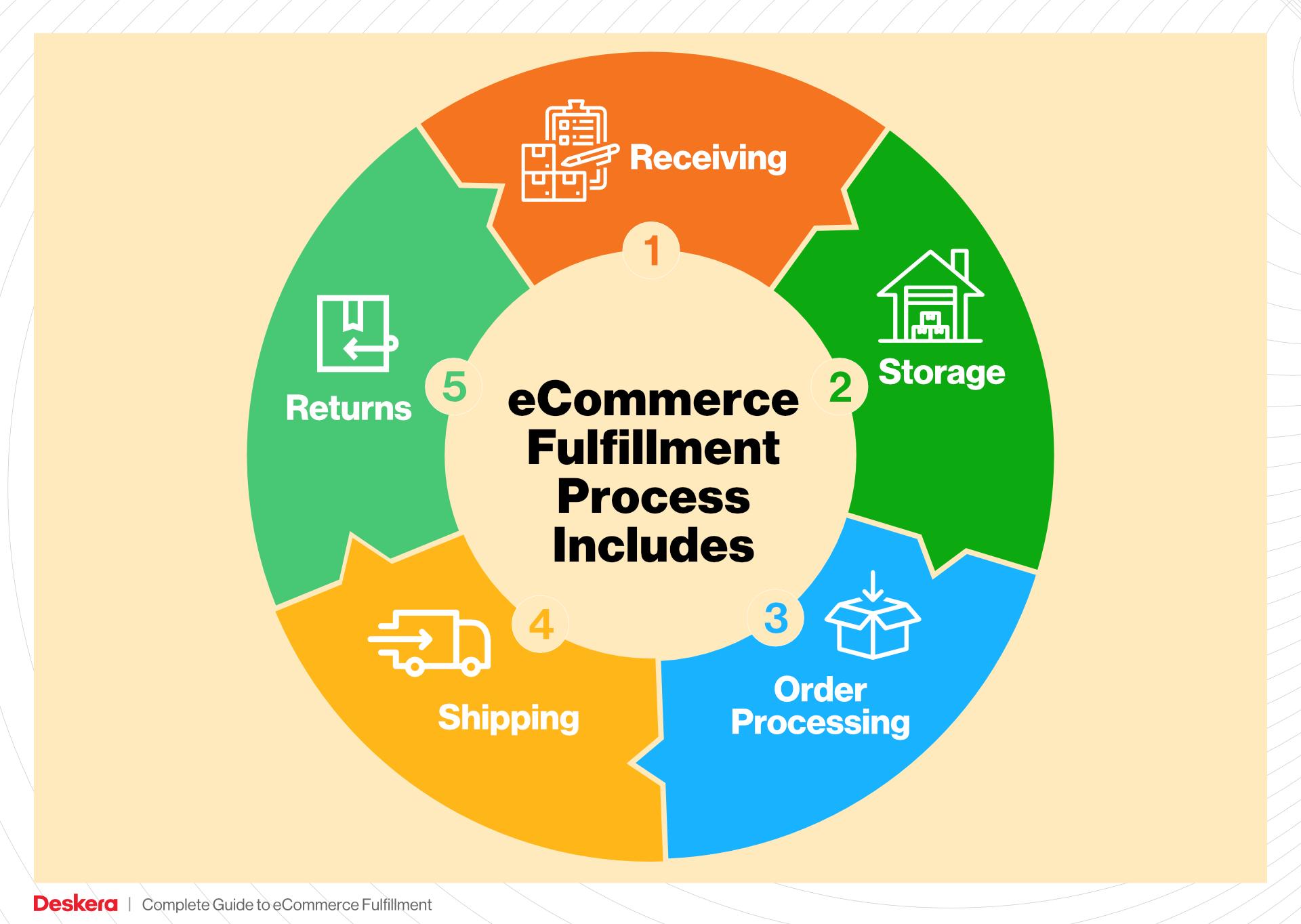
What You’ll Learn In This Guide
- What is E-commerce Fulfillment? An Introduction for Growing Businesses
- The Order Fulfillment Process: From ‘Buy’ Button to Customer’s Door
- Comparing Fulfillment Models: In-House vs. 3PL vs. Dropshipping
- A Deep Dive into Amazon FBA: Pros, Cons, and Who It’s For
- Core Services Offered by Fulfillment Centers
- How to Choose a Fulfillment Partner: A 6-Point Checklist
- Understanding Fulfillment Pricing: A Breakdown of Common Fees
- Frequently Asked Questions (FAQs) about Fulfillment
- Conclusion: Is Outsourcing Fulfillment the Right Move for Your Business?
- Important Disclaimer
The Order Fulfillment Process: From ‘Buy’ Button to Customer’s Door
1. Receiving Inventory
The order fulfillment process begins with receiving inventory, which is a critical step in ensuring that the right products are available for sale. When new stock arrives at the warehouse, it is essential to check for accuracy against purchase orders. This involves verifying quantities, inspecting for damages, and ensuring that the correct items have been delivered.
This step is crucial because any discrepancies can lead to stockouts or overstock situations, impacting customer satisfaction and operational efficiency. Effective inventory management practices, such as using Stock Keeping Units (SKUs) for each product, allow businesses to track items accurately and streamline the receiving process. Implementing a systematic approach to receiving inventory not only helps maintain accurate stock levels but also supports better forecasting and planning efforts.
2. Warehouse Storage
Once the inventory is received and verified, the next step is warehouse storage. This involves placing products in designated storage locations within the warehouse. Efficient storage strategies are essential to maximize space and ensure that items can be easily accessed when orders are placed.
Proper warehouse organization can involve categorizing products by type, size, or sales velocity. Utilizing a Warehouse Management System (WMS) can enhance this process by automating the tracking of inventory locations and quantities. This step is important because well-organized storage reduces the time spent searching for products during order picking and minimizes the chances of errors. Key terms associated with this step include “slotting,” which refers to the process of determining the most efficient placement of products within the warehouse.
3. Order Picking
Order picking is the process of retrieving items from their storage locations to fulfill customer orders. When a customer places an order, an order picker generates a pick list detailing the items and their locations within the warehouse. This document serves as a guide for warehouse staff to gather the correct products efficiently.
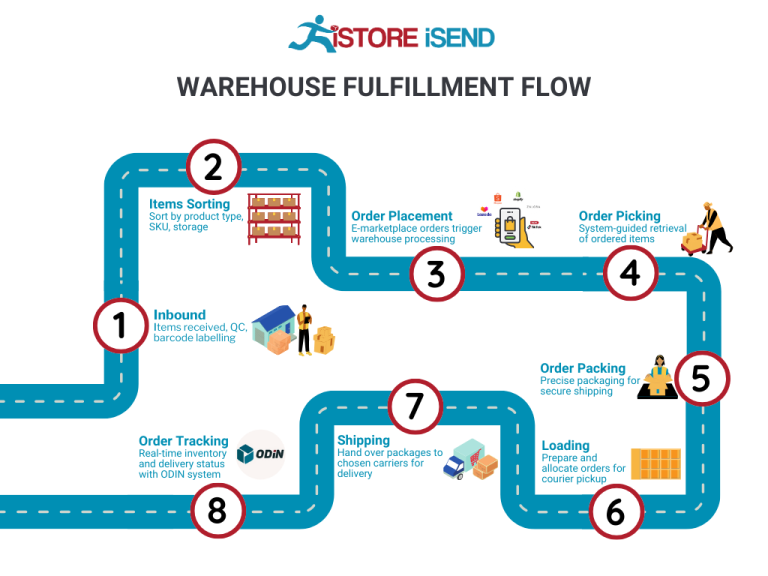
The importance of accurate order picking cannot be overstated. Mistakes at this stage can lead to incorrect shipments, resulting in customer dissatisfaction and increased return costs. Implementing batch picking or zone picking strategies can significantly enhance efficiency, especially in high-volume environments. Key terms relevant to this stage include “pick lists” and “RFID technology,” which can assist in tracking items during the picking process and ensuring accuracy.
4. Order Packing
After items have been picked, they move to the packing stage. Here, products are carefully packed into boxes or containers for shipping. This step involves not only placing items in protective packaging to prevent damage during transit but also generating shipping labels and necessary documentation.
Order packing is critical because it directly impacts the customer’s unboxing experience and the overall satisfaction with their purchase. Using packing slips and ensuring that the right items are included in each shipment are essential for maintaining accuracy. Additionally, businesses should consider implementing a quality control check at this stage to minimize errors. Key terms associated with order packing include “packing slips” and “dimensional weight,” which can affect shipping costs based on package size.
5. Shipping & Delivery
The final step in the order fulfillment process is shipping and delivery. Once orders are packed and labeled, they are handed over to shipping carriers for delivery to customers. This stage involves selecting the appropriate shipping method based on factors such as cost, delivery speed, and customer preferences.
Timely delivery is a crucial factor in customer satisfaction; hence, businesses should track shipments and communicate updates to customers regarding their order status. Utilizing shipping software can streamline this process, allowing for real-time tracking and notifications. It’s important to choose reliable carriers and maintain good relationships with them to ensure consistent service quality. Key terms relevant to this step include “last-mile delivery,” which refers to the final leg of the shipping journey and is often the most complex and costly part of the logistics chain.
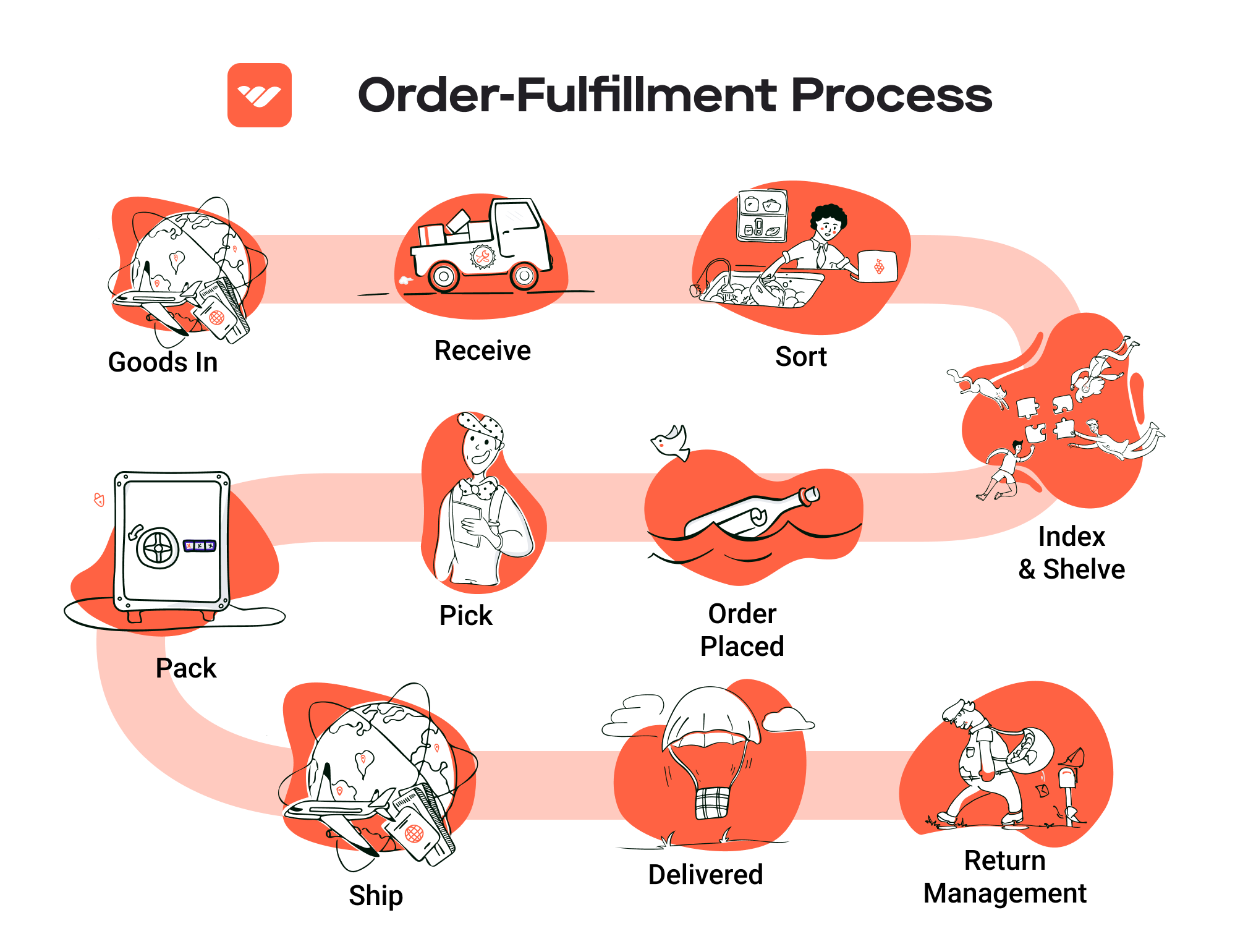
By understanding and optimizing each step of the order fulfillment process, e-commerce businesses can enhance operational efficiency, reduce costs, and ultimately improve customer satisfaction—key elements for scaling in today’s competitive market.
Comparing Fulfillment Models: In-House vs. 3PL vs. Dropshipping
Fulfillment Model Comparison Table
| Model | Who Handles Inventory | Best For (Business Stage) | Key Advantage | Key Disadvantage |
|---|---|---|---|---|
| In-House Fulfillment | The business itself | Established businesses | Complete control over inventory and processes | High overhead costs and resource allocation |
| Third-Party Logistics (3PL) | A specialized logistics provider | Growing businesses | Scalability and reduced operational burden | Less control over inventory and fulfillment |
| Dropshipping | Supplier or manufacturer | Startups and small businesses | Low startup costs and minimal risk | Lower profit margins and potential quality issues |
In-House Fulfillment
In-house fulfillment involves managing the entire logistics process internally, from inventory management to shipping. This model is often adopted by established businesses that have the resources and infrastructure to handle their logistics. One of the key advantages of in-house fulfillment is the level of control it affords; businesses can oversee every aspect of their fulfillment process, ensuring quality and consistency in their operations. Additionally, having direct access to inventory allows for quicker response times to customer demands and changes in market conditions.
However, in-house fulfillment also comes with significant disadvantages. The overhead costs can be quite high, as it requires investment in warehouse space, staffing, and technology systems. Additionally, as the business scales, the complexities of managing logistics can become overwhelming, leading to inefficiencies and potential errors in order fulfillment. For businesses looking to maintain control while also scaling efficiently, in-house fulfillment might require substantial operational shifts and resource reallocation.
Third-Party Logistics (3PL)
Third-party logistics (3PL) providers are specialized companies that manage a business’s logistics and supply chain operations. This model is particularly beneficial for growing businesses that need to scale their operations without the burden of managing logistics in-house. The key advantage of utilizing a 3PL is the ability to leverage their expertise, technology, and infrastructure, allowing businesses to focus on core activities like marketing and sales.
3PLs offer flexibility and scalability, accommodating changes in order volume and logistics requirements as businesses grow. They can also provide value-added services such as packaging, labeling, and returns management, streamlining the fulfillment process. However, the primary disadvantage of this model is the loss of direct control over inventory and fulfillment processes. Businesses must rely on their 3PL partner to maintain quality and service levels, which can lead to challenges if the 3PL does not meet expectations. Additionally, the costs associated with using a 3PL can accumulate, particularly if the business has fluctuating order volumes or requires specialized services.
Dropshipping
Dropshipping is a fulfillment model where the retailer does not keep products in stock but instead transfers customer orders directly to the supplier or manufacturer, who then ships the products directly to the customer. This model is especially appealing for startups and small businesses due to its low startup costs and minimal risk. Businesses can offer a wide variety of products without the need for inventory management, as they only purchase products after receiving customer orders.
The primary advantage of dropshipping is the ability to test new products and markets without significant financial investment in inventory. This flexibility allows businesses to adapt quickly to changing consumer preferences and market trends. However, dropshipping also has its drawbacks. Profit margins can be lower due to the additional costs associated with relying on suppliers, and there can be issues with product quality and shipping times, which can negatively impact customer satisfaction. Furthermore, businesses have less control over the fulfillment process, making it difficult to ensure consistency and reliability in service.
In conclusion, the choice of fulfillment model should align with the specific needs and stage of your business. In-house fulfillment offers control but at a high cost, while 3PL provides scalability and expertise but at the expense of direct oversight. Dropshipping is a low-risk entry point for new businesses, but it comes with challenges related to quality and profit margins. As you consider these options, evaluate your business goals, operational capacity, and customer expectations to determine the most suitable fulfillment strategy for your growth trajectory.
A Deep Dive into Amazon FBA: Pros, Cons, and Who It’s For
Understanding Fulfillment by Amazon (FBA)
Fulfillment by Amazon (FBA) is a service that allows e-commerce sellers to store their products in Amazon’s fulfillment centers. Amazon takes care of storage, packaging, and shipping, while also handling customer service and returns. This model provides sellers with the opportunity to leverage Amazon’s vast logistics network and customer base, making it an attractive option for many e-commerce businesses.
How FBA Works
-
Product Listing: Sellers list their products on Amazon and choose to enroll them in the FBA program. This involves selecting the products they want to fulfill through Amazon and ensuring they meet Amazon’s guidelines.
-
Shipping Inventory: Sellers send their products to Amazon’s fulfillment centers. Amazon provides detailed guidelines on how to prepare and ship these products to ensure they arrive in good condition.
-
Storage: Once the products are received at the fulfillment centers, they are stored until sold. Amazon manages inventory levels, which helps sellers avoid overstocking or stockouts.
-
Order Processing: When a customer places an order for a product fulfilled by FBA, Amazon picks, packs, and ships the item directly to the customer. This process is typically quick, often leading to same-day or next-day delivery for Prime members.
-
Customer Service and Returns: Amazon handles all customer inquiries, complaints, and returns related to FBA products. This includes managing refunds and exchanges, which can alleviate significant administrative burdens for sellers.
Pros of FBA
-
Prime Eligibility: Products fulfilled by Amazon are eligible for Amazon Prime, which can significantly increase sales. Prime members often prefer products that offer faster shipping options, leading to higher conversion rates for FBA sellers.
-
Customer Trust: Leveraging Amazon’s brand recognition can enhance customer trust. Shoppers are more likely to purchase items from FBA sellers, knowing they will receive reliable service and support, including easy returns.
-
Multi-Channel Fulfillment: FBA isn’t limited to Amazon sales. Sellers can use FBA to fulfill orders from other sales channels like their own website or eBay. This flexibility allows businesses to streamline their operations and reduce logistics costs across multiple platforms.
-
Automated Inventory Management: Amazon’s system provides real-time inventory tracking and management, helping sellers keep tabs on stock levels and automate reorder processes, reducing the risk of stockouts.
-
Scalability: For growing businesses, FBA offers a scalable solution. As sales increase, sellers can easily send larger quantities of inventory to Amazon without needing to invest in their own warehousing and logistics infrastructure.
Cons of FBA
-
High Fees: While FBA provides many advantages, it comes at a cost. Sellers must pay storage fees for the inventory stored in Amazon’s warehouses, as well as fulfillment fees per unit sold. These costs can add up, particularly for low-margin products.
-
Strict Inventory Rules: Amazon has stringent inventory management policies that sellers must adhere to. Non-compliance can result in penalties, including the potential removal of inventory from fulfillment centers.
-
Commingling Risks: When products are commingled, sellers’ inventory may be mixed with similar items from other sellers. This can lead to issues if a customer returns a damaged item, as the seller may not receive their original product back, affecting quality control.
-
Loss of Control: By utilizing FBA, sellers relinquish some control over their fulfillment process. This includes packaging and shipping methods, which can impact brand presentation and customer experience.
-
Complex Returns Management: Although Amazon handles returns, the process can be complex for sellers who need to track returned items and manage inventory levels effectively. This can lead to discrepancies in inventory records.
Who is FBA Best For?
FBA is particularly beneficial for:
-
Small to Medium-Sized Sellers: Businesses that may not have the resources to manage their own warehousing and logistics can benefit significantly from the ease of use and scalability offered by FBA.
-
E-commerce Entrepreneurs: Those just starting in e-commerce can leverage FBA to quickly establish a professional presence without the need for heavy investment in logistics.
-
Brands Seeking Growth: Established brands looking to expand their reach and tap into Amazon’s customer base can effectively use FBA to enhance sales and improve customer service without overextending their logistics capabilities.
-
Sellers with Fast-Moving Inventory: Products that sell quickly can benefit from FBA’s fulfillment speed, allowing sellers to capitalize on trends and maintain high customer satisfaction.
-
Multi-Channel Sellers: Businesses selling on multiple platforms can streamline their operations using FBA, allowing them to focus on marketing and product development rather than logistics.
In conclusion, while Fulfillment by Amazon offers numerous advantages that can facilitate growth and operational efficiency for e-commerce businesses, it is essential for sellers to weigh these benefits against the potential downsides. Understanding the intricacies of FBA can enable sellers to make informed decisions that align with their business goals.
Core Services Offered by Fulfillment Centers
Inventory Management & Warehousing
Inventory management and warehousing are foundational services provided by fulfillment centers that significantly enhance the operational efficiency of e-commerce businesses. This service involves the systematic handling of stock, including the storage, tracking, and organization of products within a dedicated warehouse environment.
What It Is
Fulfillment centers utilize advanced inventory management systems to monitor stock levels in real-time, ensuring that businesses have the right amount of products on hand to meet customer demand. These systems can provide insights into inventory turnover rates, seasonal trends, and reorder points, which are crucial for maintaining optimal stock levels.
Benefits
For e-commerce businesses, effective inventory management means reducing the risk of stockouts or overstock situations, both of which can be detrimental to sales and cash flow. By partnering with a fulfillment center, businesses can benefit from:
- Increased Accuracy: Automated systems minimize human error in inventory tracking, leading to more accurate stock levels and fewer fulfillment errors.
- Cost Efficiency: Centralized warehousing reduces the need for businesses to invest in their own storage facilities, lowering overhead costs.
- Scalability: As businesses grow, fulfillment centers can easily scale their inventory management solutions to accommodate increased product lines and sales volumes without requiring significant investment in infrastructure.
Pick and Pack Services
Pick and pack services are essential in the fulfillment process, involving the selection of ordered items from inventory and preparing them for shipment. This service ensures that products are accurately picked, packed securely, and dispatched in a timely manner.
What It Is
Once an order is received, fulfillment centers use organized picking systems to locate the items within the warehouse. After picking, the items are packed according to specific guidelines that ensure safety during transit. This may include using protective packaging materials and labeling for easy identification.
Benefits
For e-commerce businesses, efficient pick and pack services lead to quicker order fulfillment times and higher customer satisfaction. Key advantages include:
- Speedy Fulfillment: Streamlined processes allow for rapid order processing, which is critical in today’s fast-paced e-commerce environment where customers expect quick delivery.
- Error Reduction: Advanced picking technologies, such as barcode scanning, help ensure that the correct items are picked and packed, thereby reducing the likelihood of order inaccuracies.
- Enhanced Customer Experience: Fast and accurate order fulfillment directly contributes to positive customer experiences, encouraging repeat business and fostering brand loyalty.
Kitting and Assembly
Kitting and assembly services involve the grouping of individual items into ready-to-ship packages or kits. This is particularly beneficial for businesses that offer bundled products or customized orders.
What It Is
Fulfillment centers can pre-assemble products into kits before they are ordered, streamlining the fulfillment process. This may include assembling multiple items into a single package, applying labels, or creating gift sets that are ready for shipment.
Benefits
Kitting and assembly services provide several advantages for e-commerce businesses:
- Time Savings: By having kits pre-assembled, businesses can significantly reduce the time spent on order fulfillment, allowing for faster delivery to customers.
- Customization Options: Businesses can offer personalized bundles or gift sets that cater to specific customer preferences, enhancing the shopping experience and increasing average order value.
- Inventory Control: Kitting can help businesses manage inventory more effectively by consolidating various SKUs into a single packaged unit, simplifying stock management.
Returns Management (Reverse Logistics)
Returns management, or reverse logistics, is a critical service offered by fulfillment centers that deals with the handling of returned products. Efficient returns management is essential for maintaining customer satisfaction and optimizing inventory flow.
What It Is
This service encompasses the processes involved in receiving, inspecting, restocking, or disposing of returned items. Fulfillment centers implement systematic procedures to manage returns efficiently, including tracking return reasons and condition assessments.
Benefits
For e-commerce businesses, effective returns management can turn a potentially negative experience into a positive one. The benefits include:
- Customer Retention: A smooth and hassle-free return process can enhance customer trust and satisfaction, encouraging repeat purchases.
- Data Insights: Analyzing return data helps businesses understand customer preferences and product performance, allowing for informed decision-making regarding inventory and product offerings.
- Cost Management: Efficiently managing returns can reduce costs associated with restocking and minimize losses from returned merchandise, ultimately improving the bottom line.
In conclusion, fulfillment centers offer a suite of core services that are integral to the success of e-commerce businesses. By leveraging inventory management, pick and pack services, kitting and assembly, and returns management, companies can enhance their operational efficiency, improve customer satisfaction, and position themselves for scalable growth in a competitive marketplace.
How to Choose a Fulfillment Partner: A 6-Point Checklist
Location & Warehouse Network
Importance:
The location of your fulfillment partner’s warehouses significantly impacts shipping times, costs, and service levels. A partner with strategically located warehouses can reduce transit times to your customers, enhancing their experience and potentially lowering shipping costs.
Questions to Ask:
– Where are your warehouses located?
– How do you determine warehouse placement in relation to our customer base?
– Do you offer multiple fulfillment centers to optimize shipping routes?
– What is your average shipping time to major regions we serve?
Technology & Integrations
Importance:
In today’s e-commerce environment, robust technology and seamless integrations are vital for efficient order processing and inventory management. A fulfillment partner with advanced technology can automate many processes, providing real-time visibility into inventory levels, order status, and shipping.
Questions to Ask:
– What technology platforms do you use for order management and tracking?
– Can your systems integrate with our existing e-commerce platforms (e.g., Shopify, Amazon, etc.)?
– Do you provide real-time tracking capabilities for both us and our customers?
– How do you handle inventory updates and notifications?
Specializations (e.g., cold storage, oversized items)
Importance:
Not all fulfillment partners are equipped to handle specialized products. If your business involves cold storage items, hazardous materials, or oversized products, it’s crucial to partner with a fulfillment provider that has the necessary capabilities and certifications.
Questions to Ask:
– What types of products do you specialize in handling?
– Do you have the capacity to manage temperature-sensitive items?
– How do you handle oversized or bulky items?
– Are there any special certifications your facilities hold relevant to our products?
Scalability & Capacity
Importance:
As your business grows, your fulfillment partner should be able to scale operations accordingly. A partner that can accommodate increased order volumes without sacrificing service quality is essential for sustained growth.
Questions to Ask:
– How do you handle peak seasons or unexpected spikes in order volume?
– What is your current capacity, and how much room do you have for growth?
– Can you provide examples of how you’ve supported other clients during periods of rapid growth?
– What are your lead times for scaling up operations?
Pricing and Contracts
Importance:
Understanding the pricing structure and contract terms is crucial to ensure that your fulfillment partner aligns with your budget and business model. Transparent pricing can prevent unexpected fees and complications down the line.
Questions to Ask:
– What is your pricing structure (e.g., per order, per item, storage fees)?
– Are there any hidden fees we should be aware of (e.g., for packaging, labeling, returns)?
– What are the terms of your contracts, and how flexible are they?
– Can you provide a detailed breakdown of costs for different service levels?
Customer Support & Reviews
Importance:
Reliable customer support is key to resolving issues quickly and maintaining smooth operations. Additionally, customer reviews can provide insights into a partner’s reliability, service quality, and responsiveness.
Questions to Ask:
– What type of customer support do you offer (e.g., dedicated account manager, 24/7 support)?
– How do you handle order-related issues or customer complaints?
– Can you provide references or case studies from similar businesses?
– What are your average response times for support inquiries?
Conclusion
Choosing the right fulfillment partner is a critical decision that can significantly impact your e-commerce operations. By carefully considering these six points and asking the right questions, you can ensure that your fulfillment partner aligns with your business needs, supports your growth, and enhances your overall customer experience. Taking the time to evaluate potential partners thoroughly will pay dividends as your business scales and evolves.
Understanding Fulfillment Pricing: A Breakdown of Common Fees
Initial Setup Fees
When partnering with a fulfillment center, the first cost you may encounter is the initial setup fee. This fee typically covers the onboarding process, which includes integrating your e-commerce platform with the fulfillment center’s systems, setting up inventory management protocols, and customizing order processing workflows.
The calculation of initial setup fees can vary significantly among providers, but you can expect to pay a flat rate or an hourly fee for the time spent on system integration and setup. Some fulfillment centers might waive this fee if you commit to a long-term contract or meet certain volume thresholds.
Receiving Fees
Receiving fees are incurred when the fulfillment center accepts your inventory shipments. These fees cover the labor and resources required to unload, inspect, and process your goods.
Typically, receiving fees are calculated based on the volume of products received, often charged per pallet or per unit. If your shipment includes a high number of SKUs or requires special handling (such as temperature-sensitive items), additional fees may apply. To minimize receiving fees, consider consolidating shipments to reduce the number of deliveries made to the fulfillment center.
Storage Fees (per pallet/bin)
Storage fees are charged for keeping your products in the fulfillment center’s warehouse. These fees are often calculated on a monthly basis and can be charged per pallet, bin, or square footage occupied.
The storage fee structure can vary significantly; some fulfillment centers may offer tiered pricing based on the volume of inventory stored, while others might implement a flat rate for each pallet. Seasonal fluctuations in demand can also affect storage fees—if you anticipate higher inventory levels during peak seasons, it’s wise to discuss potential costs with your fulfillment partner ahead of time.
Pick & Pack Fees (per item/order)
Pick and pack fees are charged for the labor involved in selecting items from the warehouse and packaging them for shipment. This fee is crucial for understanding your overall fulfillment costs, as it can vary based on the complexity of your orders.
Typically, pick and pack fees are calculated per item or per order. For instance, a fulfillment center might charge a flat fee for the first item picked and a reduced fee for each additional item. If your business has a high volume of low-value items, this fee can quickly add up, so it’s important to factor it into your pricing strategy. Additionally, specialized packing requirements, such as gift wrapping or custom packaging, may incur extra charges.
Shipping Fees
Shipping fees are one of the most variable costs associated with fulfillment services. These fees cover the cost of transporting your products from the fulfillment center to your customers.
Shipping fees are calculated based on several factors, including the destination, weight, dimensions of the package, and the shipping method selected (e.g., standard, expedited, international). Many fulfillment centers have partnerships with major carriers and can provide discounted shipping rates, but it’s crucial to understand how these rates are structured. Some providers may offer flat-rate shipping for certain zones, while others may charge based on the actual carrier rates.
To optimize shipping costs, consider offering free shipping with a minimum purchase threshold or strategically selecting shipping options based on your customer demographics.
Tips for Getting an Accurate Quote
-
Clarify Your Needs: Before requesting quotes, have a clear understanding of your business model, expected order volumes, and specific fulfillment requirements. This information will enable providers to give you a more accurate quote.
-
Request Detailed Breakdown: When receiving quotes, ask for a detailed breakdown of all potential fees. This should include setup, receiving, storage, pick & pack, and shipping fees.
-
Evaluate Contract Terms: Look for any hidden fees in the contract, such as penalties for low order volumes or additional charges for seasonal spikes in inventory.
-
Negotiate: Don’t hesitate to negotiate terms with fulfillment centers. Many are willing to adjust pricing based on your projected volume or length of commitment.
-
Consider Scalability: Choose a fulfillment partner that can accommodate your growth. The pricing structure should be flexible enough to scale with your business needs without incurring excessive fees.
By understanding these common fulfillment pricing models and taking proactive steps to obtain accurate quotes, you can make informed decisions that align with your business growth objectives.
Frequently Asked Questions (FAQs) about Fulfillment
1. What is HCP fulfillment?
HCP fulfillment refers to the process of delivering pharmaceutical samples and products to healthcare providers (HCPs) efficiently and in compliance with regulatory standards. This includes managing orders, ensuring proper documentation, and tracking shipments while adhering to guidelines such as the Prescription Drug Marketing Act (PDMA).
2. How does HCP fulfillment differ from general e-commerce fulfillment?
While general e-commerce fulfillment focuses on delivering consumer products, HCP fulfillment is specifically tailored for the healthcare sector. It involves additional layers of compliance, documentation, and eligibility verification to ensure that pharmaceutical samples are distributed only to licensed HCPs, which is critical in maintaining regulatory standards.
3. What are the key compliance requirements for HCP fulfillment?
Key compliance requirements include:
– Tracking and Documentation: Maintaining accurate records of sample distribution, including recipient details and quantities.
– Recipient Eligibility Verification: Validating that recipients are licensed to receive pharmaceutical samples.
– Frequency of Verification: Regularly revalidating HCP licenses to ensure ongoing compliance.
– Limits on Sample Distribution: Adhering to regulatory limits on the quantity of samples provided.
– Acknowledgment of Receipt: Obtaining signed acknowledgments from HCPs to certify compliance with distribution rules.
4. What is a 3PL, and how does it relate to HCP fulfillment?
A Third-Party Logistics provider (3PL) offers outsourced logistics services, including transportation, warehousing, and order fulfillment. In the context of HCP fulfillment, a 3PL can manage the complexities of sample distribution, ensuring compliance, timely delivery, and efficient inventory management for healthcare practices.
5. How much do fulfillment services cost?
Fulfillment service costs vary based on several factors, including:
– Volume of Orders: Higher volumes may lead to reduced per-unit costs.
– Services Required: Additional services such as labeling, packaging, and compliance documentation can incur extra fees.
– Shipping Costs: Costs vary by carrier and shipping method.
– Storage Fees: If utilizing a fulfillment center, storage fees may apply based on the amount of inventory stored.
It’s advisable to request detailed quotes from fulfillment providers to assess potential costs accurately.
6. What is the difference between a warehouse and a fulfillment center?
A warehouse is primarily a storage facility where goods are kept until they are needed. In contrast, a fulfillment center is a specialized type of warehouse that focuses on processing orders and delivering products directly to customers or HCPs. Fulfillment centers often include additional services such as inventory management, order processing, and shipping logistics.
7. Can I sell HCP samples on multiple platforms?
Yes, you can sell HCP samples on multiple platforms, including Amazon, eBay, and your online store. However, it’s essential to comply with all relevant regulations and ensure that you have the necessary brand authorization and documentation in place, as outlined by your wholesale supplier.
8. What should I look for in an HCP fulfillment partner?
When selecting an HCP fulfillment partner, consider the following criteria:
– Compliance Expertise: Ensure they have a strong understanding of regulatory requirements, including PDMA compliance.
– Technology Integration: Look for platforms that offer automated compliance tracking and order management.
– Scalability: Choose a partner that can grow with your business and handle increased order volumes.
– Customer Service: Reliable support and communication are crucial for resolving issues promptly.
9. How can I optimize my HCP fulfillment process?
To optimize your HCP fulfillment process, consider the following strategies:
– Automate Compliance Tracking: Use technology that automates documentation and eligibility verification.
– Streamline Order Processing: Implement an intuitive ordering platform for HCPs to manage their requests easily.
– Regular Training: Ensure your staff is trained on compliance regulations and fulfillment procedures.
– Utilize Data Analytics: Monitor performance metrics to identify bottlenecks and improve efficiency.
10. What role does technology play in HCP fulfillment?
Technology plays a critical role in HCP fulfillment by automating processes, ensuring compliance, and improving order management. Platforms that offer features like electronic signature capture, centralized account management, and real-time tracking help streamline operations and enhance the overall efficiency of sample distribution, allowing healthcare practices to focus more on patient care.
Conclusion: Is Outsourcing Fulfillment the Right Move for Your Business?
Evaluating the Benefits of Outsourcing Fulfillment
Outsourcing your fulfillment operations can be a strategic move that offers numerous advantages, particularly for e-commerce businesses aiming to scale efficiently. One of the most significant benefits is time savings. By delegating warehousing, order processing, and shipping tasks to a specialized partner, you free up valuable resources that can be redirected toward core business activities such as product development, marketing, and customer engagement. This operational efficiency is essential in a fast-paced e-commerce environment where agility can determine market success.
Additionally, scalability becomes far more manageable. As your business grows, so do the complexities of your logistics. A fulfillment partner provides the infrastructure and expertise to handle increased order volumes without the need for substantial upfront investment in warehousing and staff. This flexibility allows you to adapt quickly to market demands, seasonal fluctuations, or new product launches, ensuring you can meet customer expectations consistently.
Moreover, partnering with a fulfillment service grants you access to specialized expertise. These providers are well-versed in the latest logistics technologies and compliance regulations, ensuring that your operations not only run smoothly but also adhere to necessary standards. Such knowledge can mitigate risks associated with shipping errors and regulatory compliance, which are particularly crucial in regulated industries like healthcare.
However, the success of outsourcing fulfillment hinges on selecting the right partner. Conduct thorough due diligence to ensure that the fulfillment service aligns with your business goals and can scale alongside your growth.
Call to Action
To determine if outsourcing fulfillment is the right next step for your business, conduct an audit of your current shipping processes. Assess areas where inefficiencies exist, and consider how a fulfillment partner could enhance your operations. Embracing this strategic shift could be the key to unlocking your business’s potential. Take the first step today toward a more efficient and scalable fulfillment strategy!
Important Disclaimer
⚠️ Important Disclaimer
The information in this guide is for educational purposes. Fulfillment services, pricing, and platform features change frequently. Always conduct your own due diligence and consult with providers directly before making business decisions.
